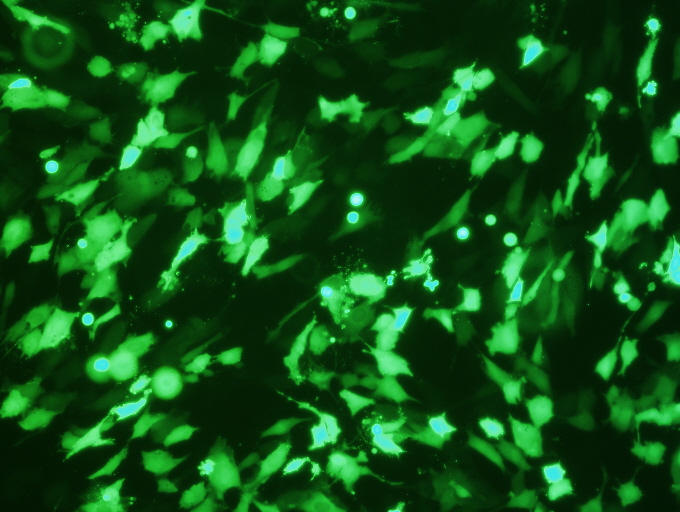Description
Cell to transfect:
Designations: BJ Cell
Cell Synonyms: : CRL-2522
Organism: Homo sapiens (human)
Tissue: skin; foreskin
Age: newborn
Gender: male
Morphology: fibroblast
Growth Properties: adherent
Depositors: J.R. Smith
The line was established from skin taken from normal foreskin. The BJ cell line has a long lifespan in comparison with other normal human fibroblast cell lines. They have been reported to have a maximal life span of 85 to 90 population doublings [PubMed: 9454332]. These cells have a reported normal diploid karyotype at population doubling 61 but an abnormal karyotype at population doubling 82 [PubMed: 9916803]. They are telomerase negative [PubMed: 10330139]. The cells may be used for stable transfection studies.
Features of the Transfection Reagent
- Broad spectrum for the transfection of large plasmid, mRNA, siRNA, and/or other type of nucleic acids, which is best for co-transfection of different type and/or size of nucleic acids.
- Specifically optimized to deliver nucleic acids into BJ cell
- Highest efficiency to ensure experimental success
- Lowest Cellular Toxicity-maintain cell density and reduce experimental biases
- 0.5 ml is able to transfect about 1000 wells of 24-well plate
- Synthesized from 100% animal origin-free components, making it easy to validate the absence of zoonotic diseases, such as BSE or viruses, in research experiments or cells lines
- Compatible with serum
- Suitable for Reverse Transfection
- Compatible with transfection in any plate formats
- Reproducible: due to highly controlled chemical synthesis of each of the ingredients, the reagent forms uniformly sized complex particles with nucleic acids. With optimized protocol, our reagent will ensure the reproducible highest transfection results.
- Economical: High efficiency means less amount of nucleic acid & reagent is needed
- Developed and manufactured by EZ Biosystems
Data
 FIG. 1. High throughput test of transfection efficiency (determined as RLU/mg) on BJ cells after transfection of luciferase reporter gene by using our 172 proprietary transfection formulas and several most popular commercial transfection reagents. The yellow box showed the results of 4 commercial transfection reagents. The red lines marked our candidate formulas with the highest transfection efficiency for BJ cells. This test result was confirmed with repeat experiments. The one that showed the optimal balance of potent & low cytotoxicity among those candidate formulas after flow cytometry analysis on the percentage of 7AAD positive cells was later named as this BJ Cell Avalanche Transfection Reagent.
FIG. 1. High throughput test of transfection efficiency (determined as RLU/mg) on BJ cells after transfection of luciferase reporter gene by using our 172 proprietary transfection formulas and several most popular commercial transfection reagents. The yellow box showed the results of 4 commercial transfection reagents. The red lines marked our candidate formulas with the highest transfection efficiency for BJ cells. This test result was confirmed with repeat experiments. The one that showed the optimal balance of potent & low cytotoxicity among those candidate formulas after flow cytometry analysis on the percentage of 7AAD positive cells was later named as this BJ Cell Avalanche Transfection Reagent.
 FIG. 2. BJ cells were transfected with GFP vector (pEGFP-N3) by using BJ Avalanche® Transfection Reagent. The cells were visualized by Nikon Eclipse Fluorescence microscope 24 hours post transfection.
FIG. 2. BJ cells were transfected with GFP vector (pEGFP-N3) by using BJ Avalanche® Transfection Reagent. The cells were visualized by Nikon Eclipse Fluorescence microscope 24 hours post transfection.
For Other Cells
BJ Cell Avalanche® Transfection Reagent can also be used on the following cells with high transfection efficiencies.
Vero Cell
293 Cell
293T/17 Cell
IMR-90 Cell
COS-7 Cell
BHK-21 Cell
3197-3 Cell
NIH/3T3 Cell
3T3-L1 Cell
Recommended protocols for these cells will be provided with the reagent. The protocols usually provide satisfactory transfection efficiency with invisible cytotoxicity. However, optimization may be needed for certain type of cells. Optimizations may include: the amount of DNA and this transfection reagent; cell density; transfection reagent/DNA ratio, or incubation time for the mixture of transfection reagent/DNA etc. For best transfection result, we recommend using the respective cell type/cell line specific Avalanche transfection reagents. Those reagents have been optimized on both recipes and protocols, and have been proved to have the best transfection results for the respective cell lines or primary cells. You can easily find the respective Avalanche transfection reagents specific for your cells by using the filters of our product list.
Additional Information
| Weight | 0.5 lbs |
|---|---|
| Adherence Phenotype | Adherent |
| Cell Type | Fibroblast |
| Disease | Healthy |
| Names starting from | B |
| Primary/Cell Line | Cell Line |
| Product Sizes | 0.5 ml, 1.5 ml |
| Species | Human |
| Tissue Sources | Skin |
| Subcategories | Cell Type/Cell Line Specific |
Description
Protocols
MSDS
Citations or Feedback


